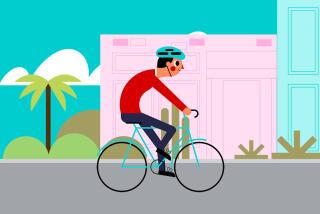Retro Bikes : 1930s to ‘50s Balloon-Tire Bicycles Worth Peddling
- Share via
NEWPORT BEACH — In an age when manufacturers race to see who can produce the lightest, fastest bike on two wheels, Rod Monday would rather plod along on 65 pounds of gleaming metal known as a 1950 Schwinn Phantom.
“It’ll tire you out,” says Monday, whose only concessions to modern technology are three-speed gears installed on the old frame.
For Monday and a growing number of vintage bike enthusiasts, it matters little that their cycles aren’t the fastest on the block.
While other bikers weigh the merits of carbon fiber and titanium frames like junior physicists, vintage bike collectors want a bike loaded with all kinds of gadgets: balloon tires, bells and buzzers, streamlined battery tanks, funky headlights and those shiny chrome fenders.
Monday rides his Phantom along the boardwalk near his Newport Beach home every day, then polishes the fenders and frame until the bike shines the way it would have on a Christmas morning 40 years ago.
“This is my baby,” he says.
Monday’s enthusiasm for old bikes is shared by no fewer than 3,000 to 4,000 collectors nationwide, according to James Hurd, curator of the Schwinn History Center in Chicago. The museum, nicknamed the “King Tut’s Tomb of Bicycles,” has about 700 bikes that date back to the 1860s and 50,000 bicycle-related items.
Collecting vintage bikes is “an infant hobby that has just awakened,” Hurd adds.
Some buy old bikes as an investment. On rare occasions, machines found at garage sales have traded hands for up to $10,000, Hurd says. Collectors have seen prices for balloon-tire bikes inflate five-fold in the last three years.
Yet the real reason many treasure vintage bikes is not to make money but to live out a long-cherished childhood fantasy.
“Riding one of these,” Hurd says, “makes you feel like a kid again.”
While older turn-of-the-century bikes have always been collectible, Hurd says, it’s the later models produced in the ‘30s, ‘40s and ‘50s that have caught fire with collectors.
“They remind us of an era when we first had mobility but limited responsibility. You could jump on one of these bikes and in a minute and a half you’d be far enough from home where you couldn’t hear your mother calling you to mow the lawn.”
Hurd himself sounds like an overgrown kid when he says, “There’s nothing like putting a baseball card in a clothespin, clipping it on the fender brace and placing it in the wheel so it sounds like a motor.”
Vintage bikes have become especially popular with the Baby Boom generation, whose parents often couldn’t afford to buy them the bikes when they were children.
Monday, 46, remembers looking longingly at ads for the Phantom in the back of comic books.
“I always wanted one, but my dad made 90 cents an hour and he said, ‘No way,’ ” Monday recalls. The bikes originally cost $79.95, a large sum in those days but not nearly as large as what they sell for today. Monday recently turned down an offer to sell his Phantom for $2,500.
Everywhere Monday rides his Phantom, passers-by greet him with long stares and the same old jokes.
“They always say, ‘Oh, it’s a Pee-wee bike.’ Then they make that laugh Pee-wee Herman makes,” Monday says with a shudder. “If it happens one more time I’m gonna . . . “
Monday can blame Pedal Pusher in Newport Beach for his troubles. The vintage bicycle shop restored a 1948 red Schwinn DX for the movie “Pee-wee’s Big Adventure.”
“The producer came in here, saw the bike and took it back to the studio. Then we got a call from the studio saying they needed 13 bikes exactly like it,” says Mike Vorgang, Pedal Pusher’s owner.
“We were calling all over the country looking for parts” to build more bikes, he said.
Vorgang and his mother, Gertrude, started restoring and selling vintage bikes 15 years ago. Pedal Pusher now helps Monday and others rebuild bikes from parts that they find all over the country, using old catalogues to figure out how the machines looked when they rolled off the assembly line.
Schwinn introduced the first bike with balloon tires in Chicago in 1933, according to Hurd. The cycles had 26-inch frames and 2.125-inch-wide white-wall tires. They remained an industry standard until 1959, when 10-speeds with skinny tires took over the market.
From the ‘30s to the ‘50s, about 38 million balloon-tire bikes were produced, but finding them in good condition isn’t easy. The batteries inside the tanks that operated the front headlights and electric horns leaked, corroding the tank and frame, Vorgang says.
In addition, young owners would sometimes strip down the bikes, yanking off fenders to make them lighter and faster. Years of neglect, damp weather and dirt did the rest of the damage.
Still, some lucky collectors have found old bikes largely intact at garage sales and swap meets. One collector found a Black Phantom for $35 at a garage sale, Hurd says. Phantoms, among the most sought-after of the classic bikes, usually sell for about $2,000.
“Balloon-tire bikes can still be found at affordable prices and they all have a personality,” Hurd says.
“The Schwinn Streamline Aero Cycle had outlandish lines, with a tank that wrapped around the front,” Hurd says. A headlight shone out from the tank instead of its usual position atop the front fender.
Many models like the Aero Cycle had an aerodynamic look, which did little to increase their speed.
Says Vorgang: “The bikes just look like they go fast.”
Bike buffs range from the weekend hobbyist who has one or two vintage bikes to serious collectors who stock their garages with museum-quality cycles.
Jed Donahoe, his wife and three sons all ride vintage bikes. They float along on the fat tires, sounding their horns and bells.
“The bikes turn heads when we ride them,” says Donahoe, a Huntington Beach resident.
His son Colin, 11, has a 1947 Schwinn DX much like Pee-wee’s that he and his father assembled from parts and painted cranberry and cream.
“Most of my friends like the old horn and the things they used to have on the bikes back then,” Colin says.
Rob Miller has constructed a 500-square-foot cottage in back of his Buena Park home to house his collection of rare, antique bikes that he jokingly calls “the dirty dozen.”
Miller favors original, turn-of-the-century bicycles such as his 1884 high-wheel safety cycle made by Smith Machine and called the Star. With the help of four or five machinists, he has restored luster to the cycle’s spindly, nickel-plated frame.
The bike sold for $135 when new, making it a rare specimen because only the wealthy could afford to buy one. It differs from most high wheels because it has a small wheel in front instead of the back, designed to prevent riders from falling forward off the big wheel and landing on their heads.
Miller sold off a larger collection of balloon-tire bikes for the earlier models because he likes the handiwork that went into the antique bikes.
“I was an art major in college and this is metal art,” he says.
For him, the fun part of collecting bikes is “the hunt and the find. You can still find these bikes in second-hand stores.”
When found, most vintage bikes look like Miller’s ’34 Aero Cycle, with its rusty handlebars, corroded frame and shredded red tires.
Collectors easily spend more than $1,000 lavishing new chrome and paint on the bikes so they look like new.
Jim Bailey, owner of Vintage Cycle Saddles in Long Beach, has made a full-time job out of restoring old leather saddles for the balloon-tire bicycles. Demand for the saddles is great, especially those for the Schwinn Phantoms. Bailey restores 50 to 60 bicycle seats a month.
“Usually, the seats are dilapidated,” Bailey says. “The springs are rusty and the leather is gone. It looks like they came out of a junk yard.”
He restores the saddles to their former glory, replating the metal, making new pads and adding fresh leather. The saddles cost from $80 to $450 for his top-of-the-line tool box saddle, which has a tool box built into the back of the seat.
As the supply of original bikes and parts dwindles, some companies such as Columbia have re-issued their older classic models.
“The nostalgia look is going strong in all of the hobbies,” Miller says. “It’s kind of an escape.”
More to Read
Sign up for The Wild
We’ll help you find the best places to hike, bike and run, as well as the perfect silent spots for meditation and yoga.
You may occasionally receive promotional content from the Los Angeles Times.






